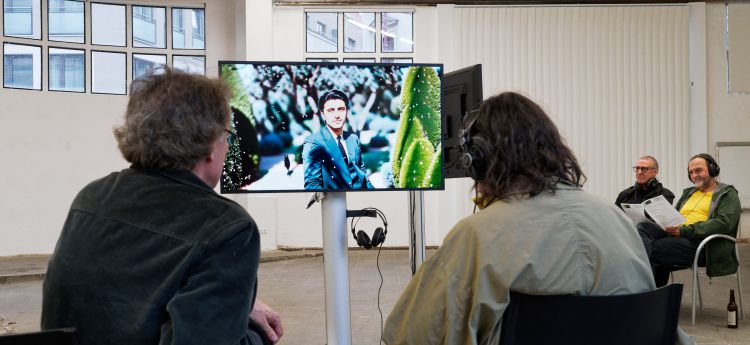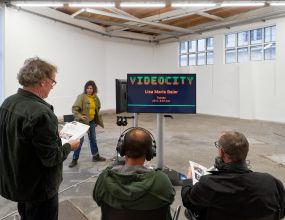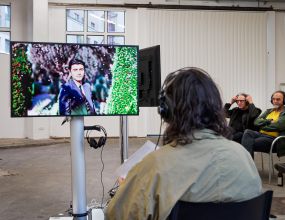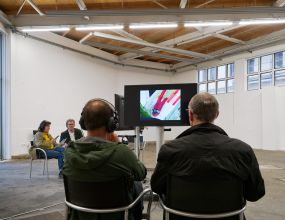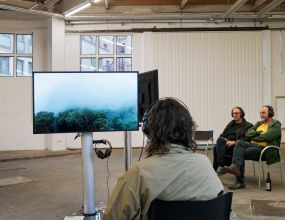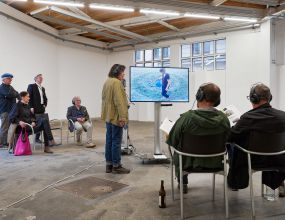The following news story has been taken from a press release produced by Videocity in May 2024.
“Let the Grassroots Grow” is a multi-part programme focussed on exploring communities and the wider international art scene, by exploring the garden, nature and ecological activities as a meeting space for communities, ideas, and culture. Our goal is to bring new perspectives with shared values and will benefit SET, riesa efau and Videocity’s communities and audiences by supporting an ongoing exchange of knowledge, experience and practice beyond borders. We aim to let the (grass)roots of each of the participants and the collaboration to grow into a sustained partnership over the years to come.
The exhibition “Let the Grassroots Grow” at the Runde Ecke is the beginning of this multi-part programme, which focuses on an exchange between the video scenes in Dresden and London. We focus on exploring communities – those from the immediate neighbourhood or those of an international art world – through the garden or greenspace. We want to find out to what extent urban natural zones serve ecological activities, the development of ideas and culture and the encounter of different people. Or in other words: what role does nature play for city dwellers? The topic was inspired by initiatives at SET and riesa efau that green their neighbourhoods, taking steps in everyday life to protect the climate and foster sustainability.
“Let the Grassroots Grow” was initiated by Videocity together with the host organisation riesa efau and the British partner SET. All organisations share the much-vaunted ‘grassroots’ ethos - a grassroots democratic attitude and personal initiative. Both combine art and society.
The current programme builds on last year's exchange with mutual visits were accompanied by digital research. We were able to get to know each other, learn from each other and research artists on site.
The exhibition shows works by artists that the teams encountered during their research or via the yearly Videocity open call. The focus is on young talent and discoveries. Three artists from Dresden and three from England, including a duo, who live between both countries, collaborating between Germany and the UK, are taking part. The videos are selected in relation to the location, reflecting green spaces and the visual experiences of passers-by.
For us, bringing together video art scenes from two different regions constitute an important gesture. Thanks to the intangible quality of video art, which enables its dissemination beyond city boundaries, we will share the results with different audiences in Dresden and London and stimulate an international discussion. We believe that many are facing similar challenges in the wake of the climate crisis.
Artists and video works
Lisa Maria Baier
Tannen, 2020
2:55 min, with sound
In this video, the artist combines stop-motion technique with film collage. The video shows small plastic fir trees that symbolise German identity and homeland – fir trees are cultural symbols romanticised in German traditions. The central theme is the examination of the concept of "Deutschtümelei", the exaggerated emphasis on the German character.
The plot unfolds in an unusual setting in which the plastic fir trees meet a wooden figure. With the typical German costume of lederhosen and a hat, the figure embodies a familiar symbolism. (Lisa Maria Baier)
Adonia Bouchehri
Ghassem, 2023
10:25 min, no sound
The animation, intended to play as a loop, has been assembled from over 4000 AI-generated images. The AI was trained over the course of two months to repeatedly generate an image of the Artist's grandfather standing in a garden in Iran, his home until the Iranian 1979 revolution. The work, titled Ghassem, is derived from the name of the artist's grandfather, who lived a tumultuous life, exiled twice due to political unrest in Iran. Reanimating him via AI technology as a young man speaks to the impossibility of really knowing the intricacies of his life. Here he is brought back as a kind of ghost — silently smiling, yet constantly changing and shifting. (Adonia Bouchehri)
Nick Crowe & Ian Rawlinson
Explaining Urbanism to Wild Animals, 2002
13:10 min, with sound
Filmed in the Cheshire greenbelt, in and around the town of Macclesfield in the north of England, Explaining Urbanism to Wild Animals features two protagonists assembling audio equipment and then playing recordings of urban construction sites in various locations. The work employs an absurd set of quasi-scientific behaviours to consider habitat loss and the impact of urban expansion upon the natural environment. (Nick Crowe & Ian Rawlinson)
Abi Palmer
Abi Palmer Invents the Weather: Light (spring season), 2023
09:30 min, with sound
Light is the third film in the series and is both a literal and abstract take on the spring season. Palmer thought it would be funny to create spring’s iridescent sunlight using a disco ball. Her cats, of course, adored the dancing reflections the ball beamed over growing patches of moss and living foliage she had stitched into the box. Cha-U-Kao the tabby cat began sleeping underneath the disco ball, occasionally waking to gaze straight up at it, the very picture of a luscious spring day. Conceptually in line with the other three films, Palmer focuses on the idea that there are things we can’t control on this planet and the lightness that comes with letting go.
Leon Michel
Touched by the Sky, 2023
5:50 min, with sound
Touched by the Sky is part of a series of documentary video works dealing with landscapes characterized by cloud drift.
Landscapes are usually perceived by people as static and have been represented in the history of visual media primarily by painting and photography - two media that are also static.
Cloudscapes, on the other hand, are characterized by permanent movement. They are dynamic landscapes that change every second.
The viewer is invited to observe these changes and to include movement as a perspective in the view of landscapes. (Leon Michel)
Veronika Pfaffinger
Minimal Gardening, 2020/21
6:05 min, with sound
Veronika Pfaffinger's minimalist intervention on a freely accessible meadow is a contemporary reflection of human influence on nature. In her astonishingly simple and yet meaningful long-term performative project, captured in a video, she waters the same circle again and again until the act of care is reflected in a ring of fresh grass, which, depending on the weather, becomes more or less noticeable. (Silke Wagler)
Curators: Andrea Domesle, Polina Chizhova und das Videocity-Team. With thanks to Rowan Bell.
Photography © Andreas Seeliger for Videocity x riesa efau Kultur Forum Dresden/Runde Ecke, May 2024
Find out more about 'Let the Grassroots Grow' on the Videocity website and the Cultural Bridge project page.

